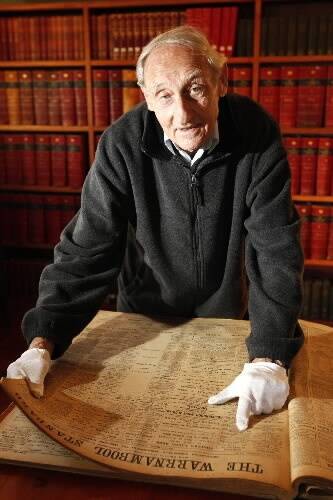
LES O'Callaghan has been alive for more than half of Warrnambool's European settlement and knows the city's fascinating past like the back of his hand.The spritely 91-year-old, together with his ``slightly younger'' wife Elizabeth, has helped preserve priceless pieces of south-west Victorian heritage.``I'm like a monkey on a stick,'' he said. ``I still feel about the same as when I was in my 50s and 60s.''Mr O'Callaghan has just stepped down as president of the Warrnambool and District Historical Society after filling the role for the past 30 years, but will continue his involvement in the background.He will have more spare time to finish his autobiography, which will give an insight into a life where the past is as important as the present. Mrs O'Callaghan is still the society's research officer and is completing a history of Warrnambool hotels and an update on the city's streets.There are not too many questions they can't find an answer to about early Warrnambool or family histories.Take for instance the derelict cottage at 94 Merri Street opposite Flagstaff Hill, which was controversially saved from demolition after Heritage Victoria ruled it was Warrnambool's oldest surviving house.Mr O'Callaghan explained the history while recalling one of the highlights of his term - the donation of an 1848 mortgage written on parchment - which is the oldest surviving legal document pertaining to Warrnambool.The mortgage was taken out by George Chisholm to build the Royal Hotel on Kelp Street.Chisholm was the brother-in-law of Richard Osburne who had purchased the whole corner block before he built 94 Merri Street and a nearby shop and allowed the Chisholm hotel development, which closed a few years later.Osburne went on to start the Warrnambool Examiner newspaper in 1851 and later wrote the first major early history of the town.In his history book, Osburne apologised he did not have any surviving copies of the 1851 publications to refer to. However, a copy came to light more than 140 years later when an 1851 Examiner was donated to the historical society.``It was a thrill to discover it existed. The newspaper had been on a shelf in a Warrnambool solicitor's office,'' Mr O'Callaghan said.He has compiled a timeline of key events in Warrnambool's history that can be extended to include current events. It will serve as a legacy to his dedicated research.The settlement dates back to May 1845 when Superintendent LaTrobe visited the fledgling port and allocated 250 acres (101 hectares) to build a town bounded by what are now Merri, Japan, Lava and Ryot streets.When Mr O'Callaghan became president the re-formed society had been running for only five years, with a vision to show the city's maritime heritage in the vacant Flagstaff Hill lighthouse keeper's cottage and chartroom.Their plan was taken up by the-then chamber of commerce president John Lindsay, who spearheaded a push to change a shabby paddock into what is now Flagstaff Hill Maritime Village.But it wasn't until earlier this year that some of the society's vast collection was moved to Flagstaff Hill from the cramped History House on Gilles Street, which is being renovated.``The work will go on forever,'' Mr O'Callaghan said. ``It grows every week.''
Subscribe now for unlimited access.
$0/
(min cost $0)
or signup to continue reading

